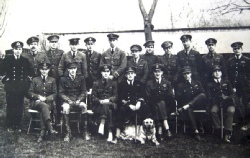We went to Walmer, in Kent, where the peace and quiet and the charming old house we had for quarters, were in striking contrast to active service conditions. There, we exchanged our 130 h.p. Clerget-engined Camels for ones with 150 h.p. Bentley B.R. 1engines. Two-thirds of the Squadron then went on leave and it was a bitter blow to all when, most unexpectedly, they had to be recalled before the end of the month. The Germans started their big Spring offensive and we were wanted urgently; so back we flew,
to Teteghem for a couple of nights, and then on to the never-to-be-forgotten La Gorgue, with the same R.F.C. Wing and brigade as before. But oh! what a change! I always look back on that trip to Walmer as the beginning of the end, and I don’t think the Squadron was ever quite the same again, though we almost got into our old form at Serny.
On 1 April 1918, the R.F.C. and R.N.A.S. were amalgamated as the Royal Air Force; we lost our Naval status and became No. 208 Squadron R.A.F. I know that, to the last man, we were very upset at the change. After being “borne on the books” of H.M. Ships for so long it seemed impossible to suddenly switch from the Naval Ranks, Ratings and Routine we knew so well, to those of the Army, adopted by the R.A.F., which were completely foreign. From a Squadron Commander, R.N., I became a Major, R.A.F., and my Flight Commanders became Captains and the Petty Officers, Sergeants. (The present-day officer ranks were not introduced until 1920.) Gone were Watch-keeping, Liberty-men, the Master-at-Arms, or “Jaunty,” the Duty Petty Officer who would report to the Officer of the Watch : “Liberty Boat along-side, Sir,” the Ship’s Bell, complete with snow-white clanging rope, and the chaps asking: “permission to go ashore, Sir,” which made the local Army and our visitors howl with delight, considering we were so many miles from the sea.
I don’t mind admitting now that I made the fullest use of the unique position we had been in before this amalgamation by pleading “Urgent R.F.C. requirements" when I required any machines or stores from Dunkirk, and, by reversing the tactics, kept the R.F.C. Staff Officers well in their places if they tried any “funny business” with the executive or administrative side of the Squadron.
reversing the tactics, kept the R.F.C. Staff Officers well in their places if they tried any “funny business” with the executive or administrative side of the Squadron.
Unofficially we never dropped the old ways completely, and a photograph, taken on the day I said goodbye to the Squadron, shows two of us still clinging tenaciously to the old uniform, long after the Armistice had been signed.













